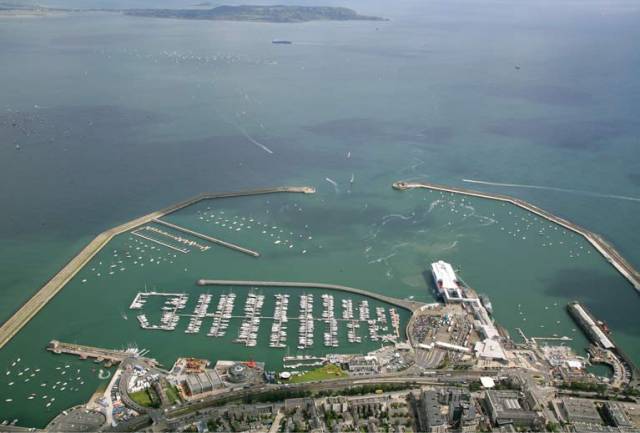Other cities are developing their waterways in imaginative ways but Dublin still can’t get it right writes David O'Brien.
Take the DART out to Dun Laoghaire today and on arrival at the station, the Iarnród Éireann announcer says: 'Dun Laoghaire - change here for ferry services.' Except from 2011 only a seasonal car ferry operated around Christmas time, and from 2015 there has been no car ferry at all. It's a small detail that reveals how disconnected the harbour has become.
Back in 2011, an artist's impression envisaged a regenerated Dun Laoghaire harbour with a cruise berth, an urban beach and a 'flotel'.
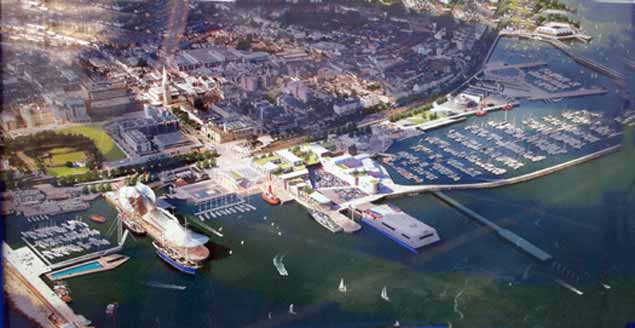 An Artist's impression of the harbour published by the Harbour Company in 2011
An Artist's impression of the harbour published by the Harbour Company in 2011
Six years later, many say such fanciful notions are all washed up. The harbour remains empty of commercial shipping. The new harbour owners, Dun Laoghaire-Rathdown County Council, are dragging their feet on what's next. Hardly befitting of the harbour town's bicentenary year, is it?
What's more, as if to symbolise how bereft of marine ideas the State harbour company has become, last month's latest attempt to cash in on the country's housing crisis with – wait for it – waterborne homes is set to run foul of existing harbour users.
But that latest slip-up is a drop in the ocean compared to the overall problems facing the great granite harbour. Dun Laoghaire's waterfront is a national monument but also a monumental challenge.
The hope, of course, it that the just-released plan of converting the old ferry terminal into office space can at least bring some life to the port.
Two Dublin-based businessmen are reported to be investing up to €20 million in the former ferry terminal to create 'a hub for technology, marine and design businesses'. It shows a new and enlightened approach by the Dun Laoghaie Harbour Company to using the vacant space which, it is claimed, could bring up to 1,000 people into the harbour area.
Creating office space is one thing; stimulating the market to create marine jobs is quite another.
Yet harbour stakeholders should do all they can to support what sounds like a positive move, because until now the only thing to show for the doomed 'master plan' is the removal of the sheds on Carlisle Pier, a cruise line debacle that has pit neighbour against neighbour and run up an estimated €2 million in consultancy fees. What is arguably the town's biggest asset is still being treated as a white elephant. After all the money spent on the masterplan, not one sod of turf has been turned.
The best suggestion that the harbour's primary users can come up with is hardly adequate, either. In the absence of a suitable paying tenant, boaters are saying the State will just have to foot the bill for harbour maintenance, 'just like they do for the Phoenix Park'.
Others have mooted, is that a bill worth footing? The purpose for which Dun Laoghaire Harbour was built is no longer required, so would it be cheaper to knock it down than maintain it? That's just one of the outlandish comments circulating in the south Dublin town due to the state of flux at Ireland's biggest boating centre.
Bizarre things have happened before. For example, in 1995, Dun Laoghaire Harbour Company filled in over 15 acres of the harbour to facilitate the construction of a new berth for the 'revolutionary' Stena HSS ferry. It was a move that gave the Swedish ferry company a monopoly in the port because no other ship could use the specially constructed mooring. Today, just 25 years later, Stena is gone, the HSS is gone, the berth is gone – but 15 acres of the harbour's precious waterspace remain filled in.
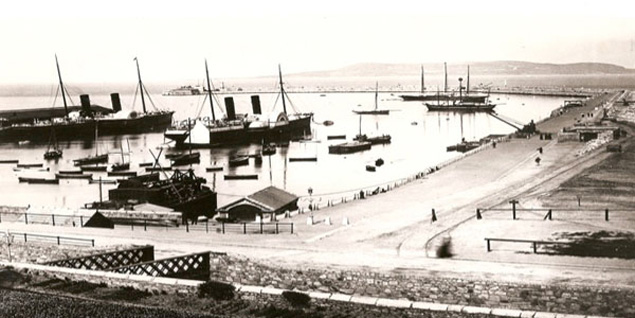 Dun Laoghaire Harbour in its heyday, a vibrant ferry port. For more than 170 years a 'mail boat' service travelled between Dun Laoghaire and Holyhead in Wales. Even during World War I the mail boat sailed, and it continued uninterrupted service until the mid 1970s. The new car ferry terminal was completed in 1969 and the ferry service, boosted in the 1990s by the HSS fast ferry, operated here until 2015
Dun Laoghaire Harbour in its heyday, a vibrant ferry port. For more than 170 years a 'mail boat' service travelled between Dun Laoghaire and Holyhead in Wales. Even during World War I the mail boat sailed, and it continued uninterrupted service until the mid 1970s. The new car ferry terminal was completed in 1969 and the ferry service, boosted in the 1990s by the HSS fast ferry, operated here until 2015
It’s obvious to all now that there's no silver bullet for Dun Laoghaire Harbour. Any hope rests, as it always did, in marine-related projects that can take advantage of the giant structure’s original intention. It needs someone with the gravitas, business nous, but most of all passion for the harbour that can turn the tide on its future.
Sounds like a tall order? Yes indeed, except that exact scenario is already playing out at another port in Ireland.
No viable plan for harbour's future
One of the problems is that the State is looking at the harbour only as built infrastructure: a site to cash in on, rather than a place with massive amenity value.
Public representatives have roundly criticised the harbour company on many fronts, but equally, is it not unfair to ask that company to produce an amenity plan when it is not charged to do so?
With 1.5 million people living on its doorstep, resulting in significant demand for marine leisure facilities, it is to our shame that there is no viable plan for Dun Laoghaire Harbour's future.
Dublin's proud boast is that it now offers not one but two world-class sports arenas in Croke Park and the Aviva Stadium. For decades to come, millions of fans will be entertained in the facilities, a tribute to the vision of the men and women who pushed for their development.
But these are not the biggest sports arenas in Dublin. That distinction goes to another site that now needs a generous amount of vision and development: Dublin Bay.
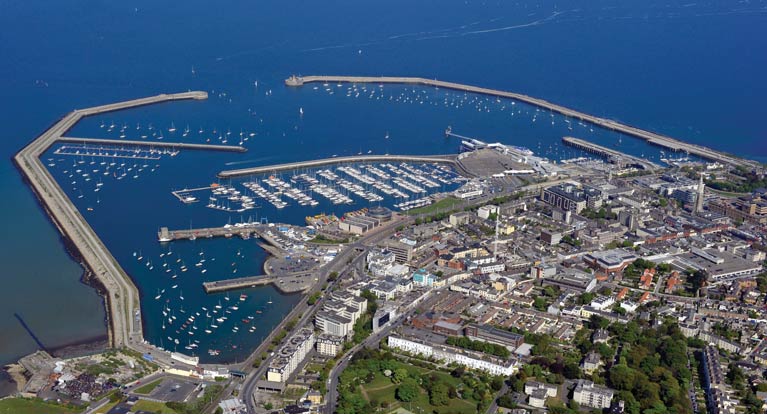 Dun Laoghaire Harbour is the gateway to the city's playground, Dublin Bay. The seaside town comes complete with a unique harbour, world-class yacht clubs and transport links, all just six miles from Grafton Street. Photo: Michael Chester
Dun Laoghaire Harbour is the gateway to the city's playground, Dublin Bay. The seaside town comes complete with a unique harbour, world-class yacht clubs and transport links, all just six miles from Grafton Street. Photo: Michael Chester
Dublin's stadiums normally feature 30 people on the field of play. In Dublin Bay, that number runs into the thousands. Dun Laoghaire Harbour is, in effect, the gateway to the city's largest sports ground.
Every weekend, the area of water between Howth Head and Dalkey is filled with sailors, divers, swimmers and fishermen, to say nothing of the hordes that simply run or walk by its shores. This resource is unique: no other European capital has this kind of natural sports amphitheatre on its doorstep.
But Dun Laoghaire, one of the world's largest man-made harbours. now faces a massive challenge. And how it is addressed may well hold the key to whether or not Dublin becomes a true capital of sport.
The harbour could be a major European marine activity centre, encompassing a variety of marine activity both commercial and leisure, including maritime research and oceanography. What's required is a vision to shape this harbour for the next 200 years and let the people of Dublin push the boat out.
People should be able to use the harbour as an active facility, and it must be possible for them to do more than just walk on its piers.
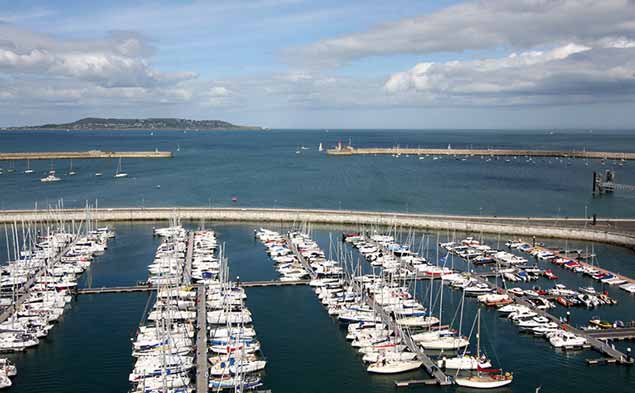 The high cost of pleasure craft berth rental rates paid to the harbour company are crippling marine leisure growth at Dun Laoghaire marina, the country's biggest boating centre
The high cost of pleasure craft berth rental rates paid to the harbour company are crippling marine leisure growth at Dun Laoghaire marina, the country's biggest boating centre
Amazingly, however, Dun Laoghaire Harbour Company offers almost no maritime activity that engages the general public, even though it is landlord to the country's largest marina – a state-of-the-art facility – and collects rent from 500 private boat owners.
It has lost its anchor tenant and has not replaced it. It is about to be taken over under new legislation and run by the local county council. Whatever official structure eventually lays claim to it will require marine expertise to properly engage with its original intention: marine use.
Instead of looking at the harbour as a site to be exploited commercially (for which, read ‘apartments’) those in charge should look for new ideas by creating a waterfront forum, with the local yacht clubs and the existing commercial operators, to promote the harbour's massive potential for high-yield marine tourism, at the very least.
There are real benefits in this, particularly for the neighbourhood. For example, the country's largest sailing event, the Volvo Dun Laoghaire Regatta, held in the harbour biennially since 2005, generates €3 million in revenues for the town. But it's not just a regatta, it's a rolling manifesto of what Dun laoghaire sailing could achieve if it pulled together.
It has been a long-standing criticism that the town centre is physically disconnected from the harbour by the railway line that runs in front of it. The council is completing cover-over sections of the line, a move to encourage more people down to see what's happening on the water, and this cannot come soon enough.
With such investment, it should be possible for local retailers – a sector in decline in the town, which, in recent times, has seen one in five shops boarded up – to pitch at the needs of the harbour and visiting ships. That was always the hope if plans to attract cruise liners had come off, but what's also required is to develop the sort of jobs that cannot be shipped abroad.
Think of the Pfizer plant in Dun Laoghaire; the cost to the Exchequer of each of those 210 or so jobs and the ease with which they upped and left. For a similar investment, we could have developed 200 jobs that would stick to Dun Laoghaire like limpets because this is where their natural advantage would exist.
These employers would not be in the old-style hunter-gatherer lifestyles (eg inshore or sea fishing) but in activity tourism and niche manufacturing and services.
As a working 'for instance', a sail making firm was established in Crosshaven, Co Cork in 1974. It's still there, a thriving small Irish business that designs and exports sails all over the world. It grew thanks to the enterprise of a local initiative by Royal Cork Yacht Club to develop festivals and events such as the world-renowned Cork Week regatta.
Dun Laoghaire has no such marine cluster. Derelict harbour buildings could be used as incubators for sailmakers, riggers, marine electronics and mechanical workshops. These businesses already exist but in a small way, currently employing up to 100 people, most of whom work out of vans without proper premises.
Dun Laoghaire is falling behind
In spite of Dun Laoghaire Harbour's position as the largest boating centre, it is now falling way behind other Irish ports. Dun Laoghaire sailing interests also need to set out a stall for the future.
The East Pier is a golden opportunity for a regulated commercial activity, but this potential is limited by the absence of services on the pier such as adequate water supply and power outlets. Major work was carried out on this pier in the past few years, but services were ignored.
Another opportunity is an adequate landing stage. The experience of other ports with cruise liner traffic is that once the big ships arrive, smaller ones usually follow. There is a market for super yacht/mega yacht boats. These were calling and using the Dublin City Mooring facility on the River Liffey until it was closed, and have now mostly stopped calling to the East Coast altogether.
A suitable landing stage could also be used for events such as boat shows, all centred around the Carlisle Pier.
In addition, there are currently no opportunities for the general public to try sailing or boating without having to take a sailing course or join a club. The French system of publicly owned boats available to hire at a small cost allows easy sailing opportunities for schools and the general public.
And it's a system that could be successfully transferred to Dun Laoghaire because, against the odds, a commercial sailing school manages to operate in the harbour without any State support and many obstacles.
Research, and the experience in France and elsewhere, points to the need to establish a maritime activity centre as hub to nurture new marine businesses.
Investing in the harbour in this way could allow Dun Laoghaire to provide an ideal base for tall ships to winter and do regular maintenance. There is only one small area given over to boat yard activities in Dun Laoghaire, yet there are over 1,000 boats based in the harbour.
By allowing the expansion of yard facilities, a fully-functioning boat yard could provide full-time employment for a large number of people.
In the move from commercial port to leisure harbour, the combined marine leisure groups – such as the well-established yacht clubs with over 5,000 sailors, the maritime museum, marine trade and other users – could band together and move forward as a united users group rather than competing interests.
One example of this is the staging of a national maritime festival along the lines of SeaFest, first staged in Cork Harbour in 2015 and now an annual fixture in Galway.
In July 2010, Dun Laoghaire Rathdown County Council spent over €1m on the Festival of World Cultures. The budget figure overran by €400,000. If this level of funding is available, surely the town's maritime culture could feature, too? After all, this is the council that found €36m to build a library to overlook the harbour in the teeth of recession.
It would be an ideal opportunity to put to good use the new 8,500 sqm space presented by Carlisle Pier, the country's only exhibition space in the middle of the sea.
If that sounds like pie in the sky, it really shouldn't seem so far out of reach, as it’s this kind of thinking that’s going on elsewhere in the country.
In Cork Harbour, a politician there who can see the potential in the blue economy has been pushing buttons to promote maritime interests.
Minister for Foreign Affairs Simon Coveney, a sailor and a former Minister for the Marine, has been instrumental in securing significant marine funding to develop the €20 million Beaufort Centre. It’s the final piece of a jigsaw that makes Cork Harbour a world-renowned marine research and development location, helping to unlock Ireland's maritime and energy potential.
It's been the same in Galway, where the Marine Institute is based and has developed world-class marine expertise. These efforts have come about under the stewardship of John Killeen, chair of the institute and an experienced sailor.
Coveney and Killeen are 'harbour czars', passionately and cleverly pushing the maritime agenda because they can see how it can benefit the local and national economies.
So where is Dun Laoghaire Harbour's world class marine research centre? Where is Dun Laoghaire Harbour's slice of the Government marine budget pie? Where is Dun Laoghaire Harbour's czar?



























